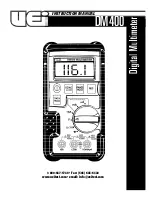
34
True RMS AC Measurements
The AC measurement of the multimeter has true RMS response. Power dissipated in a
resistor is proportional to the square of an applied voltage, independent of the wave
shape of the signal. This multimeter accurately measures true rms voltage or current, as
long as the wave shape contains negligible energy above the meter’s effective bandwidth.
The effective AC voltage bandwidth of the multimeter is 1 kHz, while the effective AC
current bandwidth is 1 kHz.
Waveform
Shape
Crest Factor
(C.F.)
AC RMS
AC+DC RMS
0
V
2
V
2
V
2
0
V
3
V
3
V
3
0
V
t
T
(50% duty cycle)
1
V
C.F.
V
C.F.
The multimeter's AC voltage and AC current functions measure the AC-coupled true rms
value, the RMS value of only the AC components of the input waveform are measured
(DC is rejected). As seen in the figure above; for sine waves, triangle waves, and square
waves, the AC–coupled and AC+DC values are equal, because these waveforms do not
contain a DC offset. However, for non–symmetrical waveforms (such as pulse trains) there
is a DC voltage content, which is rejected by the multimeter’s AC–coupled true rms
measurements.
The AC coupled true RMS measurement is especially useful for measuring small AC
signals in the presence of large DC offsets. For example, this situation is common when
measuring AC ripple present on DC power supplies. However, there are situations where
you might want to know the AC+DC true RMS value. You can determine this value by
combining results from DC and AC measurements, as shown below:
2
2
ac dc
ac
dc
For the best AC noise rejection, you should select "Low" measurement speed to get 5½
digits
reading resolution when performing the DC measurement.
Содержание MP730424
Страница 1: ...i MP730424 Digital Multimeter User Manual...








































